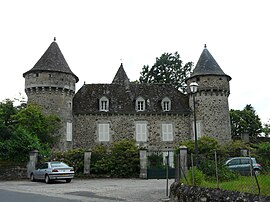|
Saint-Étienne-de-Chomeil
Saint-Étienne-de-Chomeil (French pronunciation: [sɛ̃.t‿etjɛn də ʃɔmɛj]; Auvergnat: Sent Estèfe de Chaumelh) is a commune in the Cantal department in south-central France. It belongs to the Parc Naturel Régional des Volcans d'Auvergne. GeographyThe river Rhue forms all of the commune's northern border. Population
Sites of interest
Dedicated to Saint-Étienne — French for Saint Stephen — this church takes elements from both Roman and Gothic architectures. Built during the 11th and 12th centuries, it is a Monument Historique since 1993. One of its most characteristic features is its south-west capital, supporting a Sagittarius and two faces, one of which — the right one on the picture below — features an enormous tongue.  The capital sporting the Sagittarius (under the wheel)
Saint-Étienne's castle was built during the 14th century, then heavily modified from the 17th century onwards.
Witness of the volcanic history of the department, the Rocher d'Urlande is now a renowned rock-climbing site. See alsoReferences
Wikimedia Commons has media related to Saint-Étienne-de-Chomeil.
|
|||||||||||||||||||||||||||||||||||||||||||||||||||||||||||||||||||||||||
Portal di Ensiklopedia Dunia




